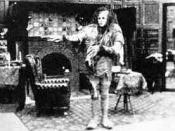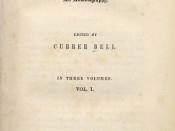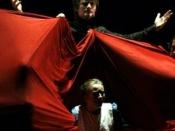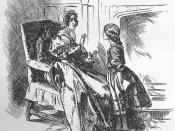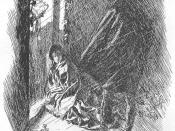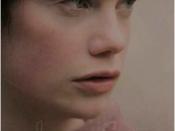Summary of Arlene Young?s ?The Monster Within: The Alien Self in Jane Eyre and Frankenstein? Young, Arlene. ?The Monster Within: The Alien Self in Jane Eyre and Frankenstein.? Studies in the Novel 23 (1991): 325-38.
Many critics have found fault with Jane Eyre. Arlene Young agrees with their view, commenting on the implausibility of Jane?s wanderings. Young feels that Jane accepts her diminishing existence with a personality devoid of spirit. As a result, her misery fails to elicit the sympathy it should. The Gothic elements of the novel provide a psychological realism to Jane?s story. Because these elements are absent in this scene, Young argues that Bronte creates, instead, a symbolic realism. By comparing Jane?s wanderings to that of the monster in Frankenstein, Young feels the symbolic undertones establish success within the episode, giving meaning to an otherwise puzzling way of transferring Jane from one imprisonment to another.
Young finds many connections between Jane and the monster.
Jane is referred to as ?mad? and a ?fiend? just as Victor Frankenstein describes his creature (327). Both characters also seem to disassociate their images from themselves. The monster is unable to identify with his reflection in a pool while Jane describes her image as a ?strange little figure there gazing at me? (Bronte 11). Also, both characters flee their makers. Like the monster, Jane flees the only place she feels at home. And while Jane is not directly fleeing her creator, she is fleeing her recreation into a person she can never be. Although both characters take similar action, their reasons for leaving are not identical. Jane must escape, yet the monster is forced away by rejection. Although the causes of their isolation differ, both characters develop a powerful sense of self-hatred and become separated from society.
Both Jane and the monster find themselves alone in the wilderness, shunning mankind. During this isolation, a deep love for nature develops. Young describes the ?cool water of the brook and the wild berries? that comfort the monster?s aching needs. Similarly, Jane describes nature as ?benign and good? as she also partakes of wild berries from the heath (331). Young describes how nature?s providence eventually drives both Jane and the monster into contact with man. The monster is drawn into a cottage at the sight of food just as Jane?s hunger leads her back to the bakery shop.
Young finds the most obvious parallels during the characters? spying scenes. The monster observes the De Laceys by crouching beside a window, just as Jane stoops outside of Moor House. Similar to Jane?s experience, the monster sees a small room, bare of furniture. He watches two young people and an elderly man, unable to distinguish their relationship and noting that all appear sad. A fire warms the room and the young man is reading aloud in a language not understood by the monster. Just as Jane feels both distanced from and attracted to the women she sees, the monster longs to join the De Laceys, but dares not. From Young?s view, the contrast between their situations and the communion from which they are excluded ?becomes the definition of their isolation? (334). Once Jane?s seclusion ends, the allusions to Frankenstein subside. While the monster is left longing for revenge, Jane is happily married to her true love.
Young feels the disappearance of parallels to Frankenstein shows Jane has successfully completed her psychological pilgrimage, escaping a monster?s alienation. As with my previous article, Young is comparing the similarities in two different novels. However, instead of the obvious similarities found in an original work and its retelling, Young has chosen to point out the accidental similarities in two, otherwise, unrelated stories. Through this approach, Young reveals the second monster of Jane Eyre.
